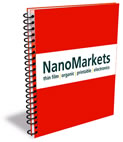Organic Photovoltaic Markets, Nanomarkets Report

The promises of organic photovoltaics (OPV) are disruptive pricing and the ability to enable entirely new products such as smart windows and solar-charged cell phones. Despite these promises, utilizing OPV will be challenging. Organic materials offer poor energy conversion ratios when compared to other thin-film PV technologies, even worse when compared to more conventional crystalline-based photovoltaics. In addition, as with all organic electronics, the active material is very susceptible to damage by water vapor and oxygen.
This new report analyzes and quantifies the market for OPV over the next eight years. It provides capacity and market forecasts, profiles both materials and solar panel firms to watch in the OPV space and takes a hard look at investment trends impacting the OPV business.
Beginning with an examination of the current state of the art in OPV, the report discusses performance issues and the various materials options including "pure" polymer approaches, small molecules, DSSC's and hybrid approaches. An analysis follows of future applications of OPV in traditional areas, as well as novel uses in integrated building systems, signage and consumer electronics. The report ends with detailed forecasts of OPV markets broken out by application, production technology and material.
Other Reports
Terms
While we only use edited and approved content for Azthena
answers, it may on occasions provide incorrect responses.
Please confirm any data provided with the related suppliers or
authors. We do not provide medical advice, if you search for
medical information you must always consult a medical
professional before acting on any information provided.
Your questions, but not your email details will be shared with
OpenAI and retained for 30 days in accordance with their
privacy principles.
Please do not ask questions that use sensitive or confidential
information.
Read the full Terms & Conditions.